Warmonger: Former Liberian
president Charles Taylor listens as he is found guilty of war crimes for
arming rebels in Sierra Leone using money from 'blood diamonds'.
Taylor, 64, was convicted yesterday of arming rebels who killed and mutilated thousands in neighbouring Sierra Leone.
Taylor
was found guilty on all counts including acts of terrorism, murder and
rape committed by the Revolutionary United Front (RUF) rebels, who paid
him for arms with diamonds mined by slave labour.
While rights
groups and Sierra Leoneans whose limbs were chopped off by the RUF
during the west African country's brutal decade-long civil war hailed
the verdict, Taylor's lawyer slammed the decision and accused the
prosecution of "buying" evidence.
In the first judgement against a
former head of state by a world court since the World War II Nuremberg
trials, Taylor was found guilty of 11 counts of war crimes and crimes
against humanity by the Special Court for Sierra Leone.
"The trial chamber finds you guilty of aiding and abetting of all
these crimes," presiding judge Richard Lussick told the UN-backed court,
situated in the leafy suburb of Leidschendam just outside The Hague.
Dressed
in a dark suit, white shirt and red tie, the former president, who once
notoriously compared himself to Jesus, stood motionless as the verdict
was read and showed no emotion afterwards.
He will be sentenced by
the same court on May 30. If sent to jail as expected he will be held
in a British prison. His lawyers and the prosecution will have two weeks
to file an appeal after sentencing.
Although the court may not
impose a death sentence or life in jail, it could impose "a number of
years", effectively meaning Taylor could spend the rest of his life
behind bars, should the judges deem his crimes severe enough.
"The
trial chamber found that the accused was instrumental in procuring and
transporting arms to RUF rebels, that he was paid in diamonds and kept
some for himself," the Samoan Judge Lussick said.
The hearings,
which saw model Naomi Campbell testify that she had received diamonds
from Taylor, lasted nearly four years, wrapping up in March 2011.
Prosecutors
alleged that the RUF paid Taylor with illegally mined so-called blood
diamonds worth millions, stuffed into mayonnaise jars.
These
diamonds would then be smuggled through a guest house used by the RUF in
the Liberian capital Monrovia in return for arms and ammunition
provided by Taylor.
Judge Lussick said the stones were gathered by the RUF in Sierra Leone, who used slave labour and enlisted child soldiers.
"Children
under the age of 15 were abducted and conscripted. They had the letters
'RUF' carved into their foreheads and backs to prevent escape," the
judge said.
Judge Lussick however stressed that while Taylor had
substantial influence over the RUF, including its feared leader Foday
Sankoh - who died in 2003 before he could be convicted by the SCSL - "it
fell short of command and control" of rebel forces.
Taylor,
Liberia's president from 1997 to 2003, had dismissed the charges as
"lies" and claimed to be the victim of a plot by "powerful countries."
During
his own 81 hours of testimony, which began in July 2009, he called the
trial a "sham" and denied allegations that he had eaten human flesh.
"These
convictions were obtained with corrupt and tainted evidence effectively
bought by the prosecution," his lawyer Courtenay Griffiths said
yesterday.
Prosecutor Brenda Hollis however lauded the verdict as "another victory for the fight against impunity."
"Today
is for the people of Sierra Leone who suffered horribly at the hands of
Charles Taylor and his proxy forces," she told reporters.
The US
said Taylor's conviction "delivers a strong message" to all war
criminals, while British Foreign Secretary William Hague said it was
proof that heads of state "cannot hide behind immunity".
UN High
Commissioner for Human Rights Navi Pillay said the "historic moment in
the development of international justice" meant tyrannical rulers could
no longer retire on blood money.
In Brussels, EU foreign policy
chief Catherine Ashton called it a "landmark" in the battle to hold
accountable all perpetrators of atrocities.
The proceedings were also relayed live by television to Sierra Leone where hundreds watched intently.
"We
as victims expect that Taylor will be given 100 years or more in
prison," said Al Hadji Jusu Jarka, a former chairman of the Amputees
Association, his prosthetic arms folded in his lap.
Authorities in
Nigeria arrested Taylor in March 2006 and he was transferred to The
Hague in 2006 after security fears in the west African country.
During Taylor's trial which began on June 4, 2007, 94 witnesses took the stand for the prosecution and 21 for the defence.
 A
diamond wholesaler recently unveiled a $15 million custom-designed
cocktail dress comprised of 100 3-carat round diamonds, during a jewelry
industry tradeshow event.
A
diamond wholesaler recently unveiled a $15 million custom-designed
cocktail dress comprised of 100 3-carat round diamonds, during a jewelry
industry tradeshow event.









